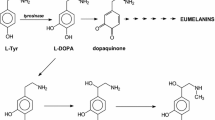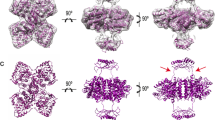Summary
The inhibitory effect of apomorphine on tyrosine hydroxylase (TH) was tested using enzyme preparations from rat striatum, neuroblastoma clone N1E-115 and pheochromocytoma clone PC-12. When the striatal enzyme preparation was incubated at pH 7.2 with (6R,S)-l-erythro-5,6,7,8-tetrahydrobiopterin (BH4) as cofactor (100–1,000 μmol/l), the IC50 for apomorphine was found to be in the 0.1–1 μmol/l range depending on the BH4-concentration used. Changing the incubation medium to pH 6.0 yielded an IC50 of about 2.5 μmol/l (BH4=100 μmol/l) Apomorphine was even less effective when 2-amino-4-hydroxy-6,7-dimethyl-5,6,7,8-tetrahydroteridine (100 μmol/l) was used as cofactor (IC50∼10 μmol/l). Similar results were obtained with the enzyme preparations of the two cell clones.
These experiments show that, even in low concentrations, apomorphine inhibits TH directly, provided more physiological test conditions are used. The relevance of these results for the autoreceptor-mediated mechanism of the apomorphine action on catecholamine synthesis is discussed.
Similar content being viewed by others
Abbreviations
- BH4 :
-
(6R,S)-l-erythro-5,6,7,8-tetrahydrobiopterin
- DMPH4 :
-
2-amino-4-hydroxy-6,7-dimethyl-5,6,7,8-tetrahydropteridine
- DOPA:
-
3,4-dihydroxyphenylalanine
- ELCD:
-
electrochemical detection
- HPLC:
-
high performance liquid chromatography
- NEAA:
-
non essential amino acid concentrate
- NSD 1015:
-
3-hydroxy-benzyl-hydrazine
- TH:
-
tyrosine hydroxylase
References
Andén N-E (1980) Regulation of monoamine synthesis and utilization by receptors. In: Szekeres L (ed) Adrenergic activators and inhibitors. Handbook of experimental pharmacology, vol 54/1. Springer, Berlin Heidelberg New York, pp 429–462
Bailey SW, Ayling JE (1978) Separation and properties of the 6-diastereoisomers of 1-erythro-tetrahydrobiopterin and their reactivities with phenylalanine hydroxylase. J Biol Chem 253: 1598–1605
Birtan M, Bustos G (1982) On the mechanism of presynaptic autoreceptor-mediated inhibition of transmitter synthesis in dopaminergic nerve terminals. Biochem Pharmacol 31:2851–2860
Bräutigam M, Dreesen R, Flosbach C-W, Herken H (1982a) Mouse neuroblastoma clone N1E-115: a suitable model for studying the action of dopamine agonists on tyrosine hydroxylase activity. Biochem Pharmacol 31:1279–1282
Bräutigam M, Dreesen R, Herken H (1982b) DOPA release from mouse neuroblastoma clone N1E-115 into the culture medium. A test for tyrosine hydroxylase activity. Naunyn-Schmiedeberg's Arch Pharmacol 320:85–89
Bräutigam M, Dreesen R, Herken H (1984a) Tetrahydrobiopterin and total biopterin content of neuroblastoma (N1E-115, N2A) and pheochromocytoma (PC-12) clones and the dependence of catecholamine synthesis on tetrahydrobiopterin. J Neurochem 42:390–396
Bräutigam M, Kittner B, Laschinski G (1984b) Effect of apomorphine, haloperidol and reserpine on DOPA production in intact PC-12 cells. A model system for testing drug effects on catecholamine biosynthesis.
Bullard WP, Guthrie PB, Russo PB, Mandell AJ (1978) Regional and subcellular distribution and some factors in the regulation of reduced pterins in rat brain. J Pharmacol Exp Ther 206: 4–20
Carlsson A (1975) Receptor-mediated control of dopamine metabolism. In: Usdin E, Bunney WE Jr (eds) Pre- and postsynaptic receptors. Marcel Dekker Inc, New York, pp 49–65
Cerrito F, Maura G, Raiteri M (1981) Do presynaptic dopamine autoreceptors exist? In: Gessa GL, Corsini GU (eds) Apomorphine and other dopaminomimetics, vol 1: Basic pharmacology. Raven Press, New York, pp 123–132
Christiansen J, Squires RF (1974) Antagonistic effects of neuroleptics and apomorphine on synaptosomal tyrosine hydroxylase in vitro. J Pharm Pharmacol 26:367–369
Delanoy RL, Dunn AJ (1982) Effects of haloperidol and apomorphine on catecholamine metabolism in brain slices. Biochem Pharmacol 31:3297–3305
Gál EM, Sherman AD (1976) Biopterin II. Evidence for cerebral synthesis of 7,8-dihydrobiopterin in vivo and in vitro. Neurochem Res 1:627–639
Goldstein M, Freedman LS, Backstrom T (1970) The inhibition of catecholamine biosynthesis by apomorphine. J Pharm Pharmacol 22:715–717
Greene LA, Tischler AS (1976) Establishment of a noradrenergic clonal line of rat adrenal phechromocytoma cells which respond to nerve growth factor. Proc Natl Acad Sci USA 73:2424–2428
Haubrich DR, Pflueger AB (1982) The autoreceptor control of dopamine synthesis. An in vitro and in vivo comparison of dopamine agonists. Mol Pharmacol 21:114–120
Herken H (1983) Clonale Nervenzellinien in der Kultur — Modelle zum Studium molekularer Grundlagen neuropharmakologischer Wirkungen. Klin Wochenschr 61:1–16
Iversen LL, Rogawski MA, Miller RJ (1976) Comparison of the effects of neuroleptic drugs on pre- and postsynaptic dopaminergic mechanism in the rat striatum. Mol Pharmacol 12:251–262
Kebabian JW, Kebabian PR (1978) Lergotrile and lisuride: In vivo dopaminergic agonists which do not stimulate the presynaptic dopamine autoreceptor. Life Sci 23:2199–2204
Kehr W, Carlsson A, Lindqvist M, Magnusson T, atack CV (1972) Evidence for a receptor mediated feedback control of striatal tyrosine hydroxylase activity. J Pharm Pharmacol 24:744–746
Kuczenski R (1973) Soluble, membrane-bound, and detergent-solubilized rat striatal tyrosine hydroxylase. J Biol Chem 248:5074–5080
Levine RA, Miller LP, Lovenberg W (1981) Tetrahydrobiopterin in striatum: localization in dopamine nerve terminals and role in catecholamine synthesis. Science 214:919–920
Lowry OH, Rosebrough NJ, Farr AL, Randall RJ (1951) Protein measurement with the Folin phenol reagent. J Biol Chem 193:265–275
Markey KA, Kondo S, Shenkman L, Goldstein M (1979) Purification and characterization of tyrosine hydroxylase from a clonal pheochromocytoma cell line. Mol Pharmacol 17:79–85
McMillen BA (1982) Striatal synaptosomal tyrosine hydroxylase activity. A model system for study of presynaptic dopamine receptors. Biochem Pharmacol 31:2643–2647
Nagatsu T, Levitt M, Udenfriend S (1964) Tyrosine hydroxylase. The initial step in norepinephrine biosynthesis. J Biol Chem 239:2910–2917
Patrick RL, Barchas JD (1974) Regulation of catecholamine synthesis in rat brain synaptosomes. J Neurochem 23:7–15
Pollock RJ, Kapatos G, Kaufman S (1981) Effect of cyclic AMP-dependent protein phosphorylating conditions on the pH-dependent activity of tyrosine hydroxylase from beef and rat striata. J Neurochem 37:855–860
Simon JR, Hegstrand LR, Roth RH (1978) Regulation of tyrosine hydroxylase from human pheochromocytoma, bovine adrenal and rat striatum. Life Sci 22:421–428
Vulliet PR, Langan TA, Weiner N (1980) Tyrosine hydroxylase: A substrate of cyclic AMP-dependent protein kinase. Proc Natl Acad Sci USA 77:92–96
Waggoner WG, McDermed J, Leighton HJ (1980) Presynaptic regulation of tyrosine hydroxylase activity in rat striatal synaptosomes by dopamine analogs. Mol Pharmacol 18:91–93
Walters JR, Roth RH (1974) Dopaminergic neurons: Drugs induced antagonism of the increase in tyrosine hydroxylase activity produced by cessation of impulse flow. J Pharmacol Exp Ther 191:82–91
Walters JR, Roth RH (1976) Dopaminergic neurons: An in vivo system for measuring drug interactions with presynaptic receptors. Naunyn-Schmiedeberg's Arch Pharmacol 296:5–14
Westerink BHC, Horn AS (1979) Do neuroleptics prevent the penetration of dopamine agonists into the brain? Eur J Pharmacol 58:39–48
Westfall TC, Glowinski J (1976) The role of presynaptic receptors in the release and synthesis of 3H-dopamine by slices of rat striatum. Naunyn-Schmiedeberg's Arch Pharmacol 292:279–287
Westfall TC, Naes L, Paul C (1983) Relative potency of potamine agonists on autoreceptor function in various brain regions of the rat. J Pharmacol Exp Ther 224:199–205
Author information
Authors and Affiliations
Rights and permissions
About this article
Cite this article
Laschinski, G., Kittner, B. & Bräutigam, M. Inhibition of striatal tyrosine hydroxylase by low concentrations of apomorphine. Naunyn-Schmiedeberg's Arch. Pharmacol. 327, 114–118 (1984). https://doi.org/10.1007/BF00500904
Received:
Accepted:
Issue Date:
DOI: https://doi.org/10.1007/BF00500904




